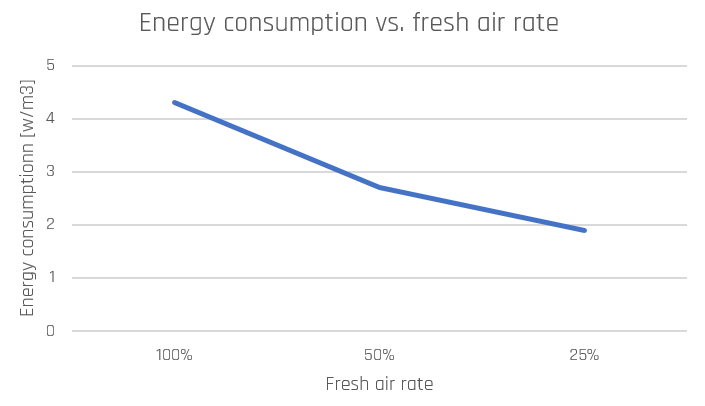Establish your moisture load and determine your required set point.
STEP ONE
The first step would be to establish what your dry air requirements are:
- Moisture load: What is the number of people in your battery dry room at any given time, now and in the future?
- Set point: What is your required dew point for optimal conditions in your battery dry rooms per your technical requirements?
- Exhaust and leakage rate: How much air is lost to keep overpressure and exhaust of fumes and dust
In defining the above, you must consider what drives the costs and energy consumption:
The moisture load from the room typically drives the airflow up, thus the size of the dehumidifier and the energy consumption to run it. The good news is that the moisture can be removed by recirculating air from the dry room to the dehumidifier. This is very energy efficient. Look here to see the needed airflow depending on the dew point and the number of people in the room.
The set point is important too. With Cotes Exergic Technology, the energy consumption for dehumidifying 1m3 of air is almost the same for dew points of -40°C and -60°C. But you would need a larger air volume if it is -60°C. More air means larger dehumidifiers and higher energy consumption. Look here to see the required airflows.
The exhaust and leakage rate dictates the size (CAPEX) of the dehumidifier and energy consumption (OPEX), as it affects the required volume of fresh air. Because 99,9% of the moisture must be removed from the fresh air, the dehumidifier requires a lot of energy and dehumidification capacity. Talk to your cleanroom supplier about ways to lower the exhaust and leakage rate.

The above is based on Cotes Exergic Technology sourced from a high-temperate heat pump. The dry room dew point of -40°C (would be identical for -60°C). Look here to see the potential savings of a using Cotes Exergic in your battery dry rooms.
STEP TWO
The second step would be to define your dehumidification strategy. Here you will need to consider the following:
- How important are energy consumption and sustainability to you and your business?
- Do you have alternative sources of energy available on site?
- What is your required dew point in the room, and will it change in the future, I.e. will you need a range of dew points?
Sustainability in focus
Batteries and battery production are part of a larger sustainability agenda. The purpose here is to cut emissions and create a world less dependent on oil and gas. Furthermore, the motivation for cutting consumption is probably high with the skyrocketing energy prices.
The Cotes Exergic Technology would be the most energy-efficient solution. A German research institute calculated an 84% saving of energy in their dry room consumption, leading to a 49% reduction in energy consumption in the entire battery manufacturing plant.
Moreover, Cotes Exergic Technology opens up alternative sourcing of sustainable energy. Where the conventional solution would require either electricity or gas, Cotes dehumidifiers can be operated on multiple sustainable energy sources like waste heat from production, district heating, high-temperature heat pumps, solar thermal panels, and biogas.
Read more about how Cotes Exergic technology works here (link) and the saving potential here (link).
Finally, the required dew point is crucial for choosing the right dehumidification strategy. A conventional one-stage dehumidifier will struggle to deliver air much drier than -50°C, it’s possible, but the energy consumption explodes, and the dehumidifier will run on its limits, with almost no safety margin.
Cotes Exergic Technology can deliver air with a dew point as low as -120°C, thus drier than you will ever need. This provides a high safety margin in case the operation of the dry room changes in the future. See more on safety margins here (link).
